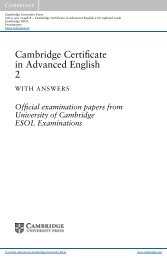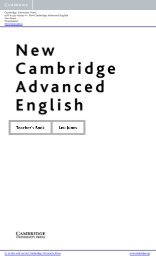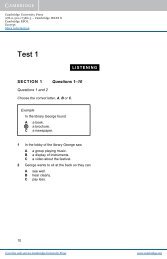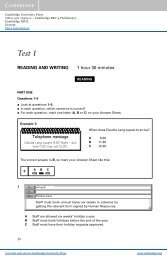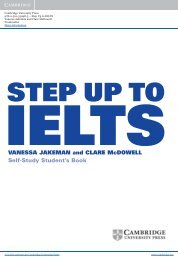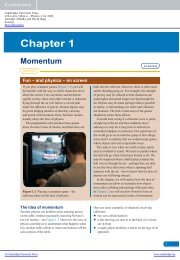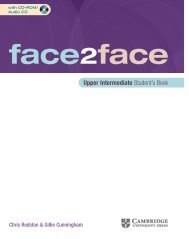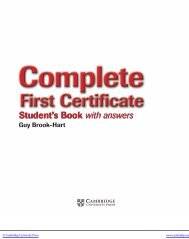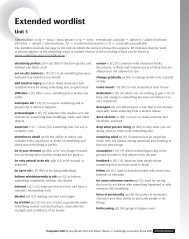Skills for Study Level 2 Teacher's Book - Cambridge University Press
Skills for Study Level 2 Teacher's Book - Cambridge University Press
Skills for Study Level 2 Teacher's Book - Cambridge University Press
Create successful ePaper yourself
Turn your PDF publications into a flip-book with our unique Google optimized e-Paper software.
2cSuggested answersDetermining the solubility of sodium chloride in water at room temperatureSodium chloride (NaCL), which is commonly known as salt, is an importantnatural substance. It occurs in nature as the mineral halite, and contains theminerals sodium (Na + ) and chloride (Cl − ). It occurs naturally in human bodiesas well as in the environment. Sodium and chloride are vital because humansrequire a particular concentration of salt in their bodies to stay healthy.Sodium chloride gathered from seawater has been used throughout humanhistory. Salt is well known as an effective way to preserve and also to improvethe flavour of food. It is an interesting but little known fact that sodium chlorideis also used to help make soap and produce paper. It is also very useful inwinter because it is used to de-ice roads and pathways.In this experiment the solubility of sodium chloride in water was determined bydissolving a given amount of sodium chloride in water in a glass beaker, andweighing the solution on a scale both be<strong>for</strong>e and after heating to evaporatethe water.2d Students compare their answers.3 Primary research reports – the methods section3aAnswersaEquipmentApparatusbProcedureMethodology3bAnswersA methods section might include:1 Diagrams ✔2 The results you obtained using the method3 Explanation of the reasons <strong>for</strong> your method ✔4 An explanation of any controls that you use ✔5 Separate subsections <strong>for</strong> ‘Materials’ and ‘Methods’ ✔6 A list of instructions <strong>for</strong> how to carry out the experiment * Seebelow7 Detailed explanations of all the equipment you used + Seebelow8 Detailed explanations of any non-standard equipment orprocedures that you use✔9 The precision of any measuring equipment you use ✔10 A discussion of how you could improve the method in future11 Citations <strong>for</strong> standard procedures created by other people ✔Unit 2 Part E ∙ Reporting in writing 64



